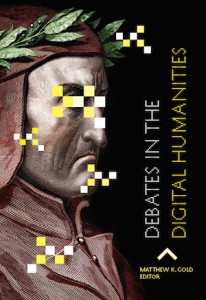Debates and the digital humanities
 There has been a flurry of debates recently surrounding the digital humanities, sparked in part by the publication of Matthew Gold’s volume, Debates in the Digital Humanities, and Stanley Fish’s extended responses in the New York Times. Annual conferences for both the Modern Language Association and the American Historical Association featured numerous roundtables and panels concerning the humanities computing, digital pedagogy and electronic infrastructures for scholarly work. The text based scholarship so vital to the work of the humanities (and its related infrastructure) is both complicated and broadened by digital technologies and the digital humanities has emerged front and center proclaiming its suitability as the discipline best positioned to explore a post-Gutenberg galaxy.
There has been a flurry of debates recently surrounding the digital humanities, sparked in part by the publication of Matthew Gold’s volume, Debates in the Digital Humanities, and Stanley Fish’s extended responses in the New York Times. Annual conferences for both the Modern Language Association and the American Historical Association featured numerous roundtables and panels concerning the humanities computing, digital pedagogy and electronic infrastructures for scholarly work. The text based scholarship so vital to the work of the humanities (and its related infrastructure) is both complicated and broadened by digital technologies and the digital humanities has emerged front and center proclaiming its suitability as the discipline best positioned to explore a post-Gutenberg galaxy.
Nearly sixty sessions at this year’s MLA had a digital humanities connection (see Mark Sample’s post). During a session on Literary Research in/and Digital Humanities convened by James R. Kelly, a Humanities Bibliographer at the University of Massachusetts Amherst, Heather Bolwby discussed some of the factors involved in successfully launching Julia Margaret Cameron’s photographic illustrations to Tennyson’s Idylls of the King as a digital resource. In her presentation, Bowlby pointed out some of the considerations she had to take into account with the project, including locating the necessary technical support, determining how the resource would function within different scholarly contexts, securing an enduring online space to house the resource, and collaborating with librarians and other professionals in related fields to fit the resource within pre-existing institutional frameworks.
So the stately Queen abode
For many a week, unknown, among the nuns;
Nor with them mix’d, nor told her name, nor sought,
Wrapt in her grief, for housel or for shrift,
But communed only with the little maid,
Who pleased her with a babbling heedlessness
Which often lured her from herself.
(Idylls of the King, Book XI – l. 144-150)
[Julia Margaret Cameron, ‘The Little Novice and the Queen’, plate XI from The Idylls of the King, albumen print 1874]
Bowlby’s project aimed at the reproduction of the physical object as much as possible in an electronic format while maintaining the appropriate scholarly framework. Yet reproduction, as anthropologist Marilyn Strathern reminds us, involves two processes. The first, is the process of replication, when the original material is duplicated. The second process is one of expression, when the replication of the original material takes shape within a new context. Bowlby presented her efforts as “case study of the problems facing graduate students involved in similar digital projects.”
The digital duplication of the physical object, whether it be a rare photograph, a manuscript or a scholarly monograph, no longer poses difficulty, but the process of its expression and its context is at the crux of many of the debates surrounding digital humanities today. What form will that expression take? Will it conform to current (and future?) standards for preservation and sustainability? And what is the appropriate context for that expression? Will it ensure its continued expression over time? Will it allow the expression to be accessible to many or to a select few? Will the context overwhelm the expression? And will that context be re-iterated or aggregated in other contexts? If so, how? Just as the potential for duplication is seemingly endless in a digital context, so too is the potential for expression and for an infinity of contexts within this boundless domain.
Pioneering photographer Julia Margaret Cameron was particularly sensitive to questions of reproduction and expression in her photographs for Tennyson’s work. Using a new and challenging medium such as photography in such unique ways for the time, Cameron’s illustrations deliberately imitated the oil paintings in the style of the contemporary Pre-Raphaelite painters. Why? As she explained simply, “my aspirations are to ennoble Photography and to secure for it the character and uses of High Art by combining the real and ideal sacrificing nothing of Truth by all possible devotion to Poetry and beauty.” Her project to “ennoble photography” is similar to the project of many digital humanists today: to ennoble their field as one worthy of expression and of context. What must the digital humanities find then to secure for it “the character and uses” of a discipline or a scholarly presence within a boundless domain of culture?
cross posted at HASTAC
